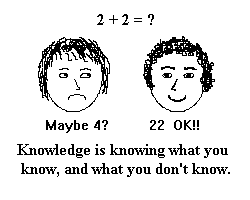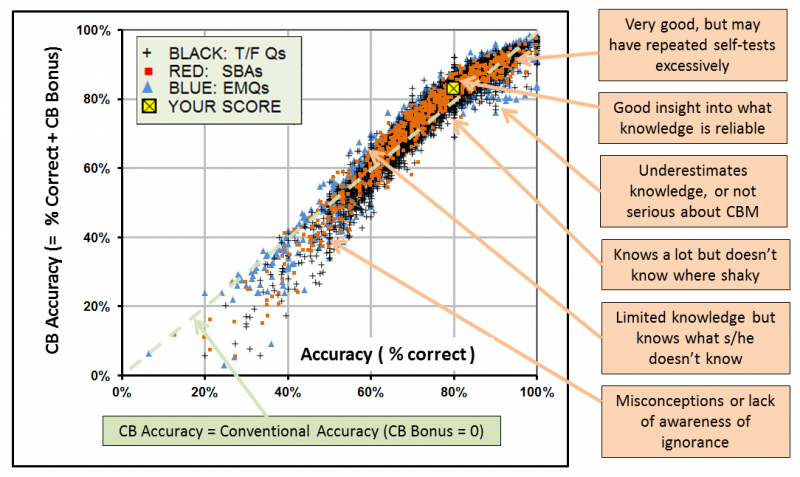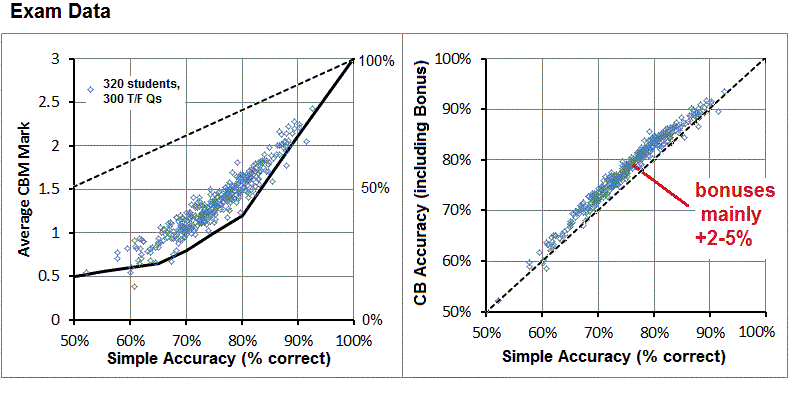Gewissheitsbegründete Bewertung
![]() Diese Seite muss überarbeitet werden. Greif zu!
Diese Seite muss überarbeitet werden. Greif zu!
Wenn du dich um diesen Artikel kümmern willst, dann kennzeichne das, indem du die Vorlage {{Überarbeiten}} durch die Vorlage {{ÜberarbeitenVergeben}} ersetzt.
Wenn du mit deiner Arbeit fertig bist, dann entferne die Vorlage aus dem Artikel.
Danke für deine Mitarbeit!
Hinweis: Die gewissheitsbegründete Bewertung (englisch: certainty-based marking, CBM) basiert auf Strategien, die von Prof. Gardner-Medwin am University College London, UK entwickelt wurden. Mehr Dokumentation dazu hier.
Was ist eine gewissheitsbegründete Bewertung?
- Bei jeder Antwort auf eine Testfrage geben Sie zusätzlich an, wie sicher Sie sich mit Ihrer Antwort sind.
- Die Angabe "wie sicher" Sie sich sind, erfolgt auf einer Gewissheitsstufen-Skala: C=1 (unsicher), C=2 (mittel), C=3 (sicher).
- Es wird nicht unterschieden zwischen "unsicher" und "sehr unsicher", weil diese Einschätzung sehr subjektiv ist.
- Die Bewertung erfolgt nach folgendem Schema:
| Gewissheitsstufen-Skala | C=1 | C=2 | C=3 |
|---|---|---|---|
| Bewertung bei richtiger Antwort | 1 | 2 | 3 |
| Bewertung bei falscher Antwort | 0 | -2 | -6 |
| Beschreibung | unsicher | mittel | sicher |
- Bei richtiger Antwort gibt es entsprechend der Gewissheitsstufen 1, 2 oder 3 Punkte.
- Bei falscher Antwort gibt es bei C=1 keine Punkte, bei C=2 einen Punktabzug von -2 Punkten und bei C=3 einen Punktabzug von -6 Punkten.
Warum sollte die gewissheitsbegründete Bewertung verwendet werden?
- Die Teilnehmer/innen müssen darüber nachdenken, wie zuverlässig ihre Antwort ist.
- Die Teilnehmer/innen werden angehalten, wirklich über den Sachverhalt nachzudenken, und nicht nur unmittelbar auf die Frage zu reagieren.
- Die Teilnehmer/innen werden herausgefordert: Wenn sie keinen Punktabzug riskieren, dann wissen sie die richtige Antwort nicht wirklich.
- Teilnehmer/innen, die ein solides Wissen zum Gegenstand der Testfrage, aber wenig Selbstvertrauen haben, können durch diese Methode ihr Selbstvertrauen stärken.
- Die Methode ist fairer in folgendem Sinne: Eine durchdachte und wohlüberlegte richtige Antwort bringt mehr Punkte als eine zufällig geratene richtige Antwort.
- Teilnehmer/innen durchlaufen einen aktiven Lernprozess, wenn sie eine falsche Antwort geben, bei der sie sich sicher sind: sie denken nach, reflektieren und lernen daraus.
- Wirkliches Wissen bedeutet genau zu wissen, was man weiß und auch, was man nicht weiß.

Wie wählt man die beste Gewissheitsstufe?
- Wenn Sie sich sicher sind bei Ihrer Antwort, dann ist es offensichtlich am besten C=3 zu wählen. Allerdings erhalten Sie einen Punktabzug von -6, falls die Antwort doch falsch ist.
- Wenn Sie unsicher sind, dann sollten Sie das Risiko eines Punktabzugs vermeiden und C=1 wählen.
- Wenn keiner der beiden obigen Fälle zutrifft, wählen Sie C=2: Sie gewinnen oder verlieren 2 Punkte, je nachdem, ob die Antwort richtig oder falsch ist.
- Die Grafik zeigt, wie auf den verschiedenen Gewissheitsstufen die durchschnittliche Punktzahl, die Sie für Ihre Antwort erhalten, davon abhängt, wie sicher Sie sich mit Ihrer Antwort sind.
- Angenommen, Sie sind sich zu 50% sicher, dass Ihre Antwort richtig ist. Bei 50% liegt die schwarze Kurve (für C=1) über den anderen Kurven, bringt Ihnen also (wahrscheinlich) die meisten Punkte. Wählen Sie daher C=1.
- Wenn Sie zu mindestens 80% sicher sind, dass Ihre Antwort richtig ist, liegt die rote Kurve (für C=3) über den beiden anderen Kurven. In diesem Fall wählen Sie C=3.
- Beachten Sie, dass Sie niemals gewinnen können, wenn Sie Ihre Gewissheit falsch angeben. Wenn Sie C=3 (rote Kurve) klicken, obwohl Sie unsicher, dann werden Sie sehr wahrscheinlich einen Punktabzug bekommen. Es kann sein, dass Sie Glück haben, aber im Schnitt werden Sie Punkte verlieren. Wenn Sie das Thema gut verstanden haben und denken, dass Ihre Antwort verlässlich ist, dann erhalten Sie weniger Punkte, wenn Sie sich für C=1 oder C=2 statt für C=3 entscheiden. Sie fahren am besten, wenn Sie gut einschätzen können, welche Ihrer Antworten verlässlich und welche unsicher sind.
Feedback about your CBM performance - Übersetzen!!!
- If you are using CBM with feedback given after each answer, then the mark tells you a lot: -6 will make you ask how you justified confidence in a wrong answer. Think (along with any available explanations and your books or notes) how to tie together different bits of your knowledge.
- If you repeatedly get answers right with C=1 then ask yourself if perhaps you know the subject better than you think. Ask how you might relate your answers to things that you definitely do know and are more confident about.
- When you finally submit, you will see your percentages correct for each C level you used. Ideally these might be around 50%,70%,90% for C=1,2,3 whether you know the subject well (lots of answers at C=3) or poorly (lots at C=1). The feedback will warn if you are tending to overestimate or underestimate how reliable your answers are. If overconfident, think about why! Perhaps you were careless; perhaps you have misconceptions, or are giving confident answers to questions you don't really understand or that are phrased ambiguously. Use this to guide your study and to improve your interaction with teachers.
- Note that some questions in a quiz may carry more weight than others, so for example you might get -12 if the question carries double weight and you make a confident error. Since this makes feedback harder to interpret, it probably isn't a good idea for quiz-setters to vary weights in this way when using CBM.
- If you've only answered a few questions, CBM feedback may not mean very much: 2 or 3 unconfident correct answers may just be luck! What is important is that you think about why you were confident or unconfident, and learn from that.
CBM Grades and Scores - Übersetzen!!!
CBM Average Mark and Accuracy - Übersetzen!!!
- The CBM Average can range between 3 and -6. If all the questions in the quiz have the same weight, then it is simply the average CBM mark, as shown in the CBM table above. If the weights (w) vary, then for CBM marks (m) awarded on each question the CBM Average = Σ(wm)/Σ(w).
- Accuracy is a conventional measure of how much you got right in the quiz, ignoring CBM ratings. If all questions carry equal weight, it is the percentage of answers that were correct (with perhaps some answers being counted as partially correct). If questions have different weights w, and answers have fractional correctness f (between 0 and 1) then Accuracy = Σ(wf)/Σ(w).
- Partially Correct Answers. If Moodle answers are partially correct (assigned a fraction f greater than zero), then for C=1, 2,or 3 the mark awarded will be f, 2f or 3f. If f is negative (implying that any correct portion of a response is outweighed by errors) then the mark awarded will be the same as for a wrong answer (0,-2 or -6).
=What do Average CBM marks and Accuracy tell you? - Übersetzen!!!
The graph* shows the scores (Accuracy and CBM average) for several thousand online submissions on a variety of voluntary CBM self-tests for learning and revision, mostly with university students. It is annotated with interpretations of the students' knowledge in different zones of the graph.

- * This graphical form is used in CBM Self-Tests (not currently in Moodle) to present a student's score after submission.
- Note that the CBM average is always less, as a percentage of maximum, than accuracy. For the score shown in yellow, the CBM average (1.5) was 50% of maximum, while the accuracy (which ignores C ratings) was 80%. You obviously shouldn't worry that your CBM average is less, expressed in this way, than your conventional score. It always is!
- If you didn't discriminate at all between reliable and uncertain answers (giving them all the same C rating, appropriate just for how well you know the topics on average), then your scores would lie somewhere on the green line on the graph.
- If your score lies above the green line, then you are successfully distinguishing reliable answers from uncertain ones. If your score lies below, then you are either misjudging how well you know and understand the topics, or you may have serious misconceptions (things you confidently believe, but that are not so!).
CBM Bonus, CB Accuracy and CB Grades - Übersetzen!!!
It is convenient to express a student's success at distinguishing reliable from uncertain knowledge in terms of a CBM Bonus that can be added to (or subtracted from) their conventional accuracy, expressing the percent correct in their answers. The CBM Bonus is determined by how much the CBM average lies above or below the green line on the graph above. A negative bonus** means the student has discriminated badly or misjudged the reliability of their answers. For the example score shown in yellow, the CBM average is 0.3 marks above the line, which is multiplied by a standard factor β (=10%)* to give a CB bonus = +3%. When added to the Accuracy (= 80%) this gives CB Accuracy = 83%. The CB Grade is simply the CB Accuracy multiplied by the grade value assigned to the quiz. Use of CB Accuracy makes it easy for students and examiners to compare conventional and CB grades, while the difference (the CB Bonus) is an indication of the student's critical awareness of which parts of his or her knowledge are and are not reliable.

- * The factor β=10% used to calculate CB Bonus is optimally chosen to maximize the statistical reliability of the resultant total score (Accuracy + Bonus): its ability to predict accurately the performance on related tests. Ref: Gardner-Medwin, 2013
- ** If you think a negative bonus strange, think how much better the world would be if bankers' bonuses could go negative. A negative CBM bonus typically flags what were described by Confucius as an inability "when you do not know a thing, to allow that you do not know it" and by Donald Rumsfeld, more concisely, as "unknown unknowns". They are both essentially negative knowledge, worse than acknowledged ignorance.
=CBM Data in Exams - Übersetzen!!!
By the time students take exams, many of their misconceptions (confident errors, leading to negative marks) will have gone, and students should be better judges of their areas of mastery and uncertainty. This means that CB Bonuses tend to be more uniformly positive. CB Accuracy allows examiners to make a direct comparison of CB standards criteria with conventional standards.

Example CBM data from a UCL medical exam using True/False questions.
CBM is particularly valuable for self-tests, where students challenge themselves as part of their study. Answers may be omitted because they are not on a topic of current interest, they are too easy, or perhaps not yet studied. CBM scores can then be presented relative to the set of questions the student has chosen to respond to. All correct on just half of a quiz would then show as 100% accurate. It is up to the student to interpret such scores: obviously if questions are omitted because they are difficult, then the relative score may overestimate competence in the subject. Moodle 'Grades' are always relative to the whole quiz, and this is the default presentation for other scores too.
=Moodle Grades with CBM - Übersetzen!!!
The Moodle Grade is the total of marks awarded, scaled relative to a nominal value for the whole quiz. Grades are sometimes shown 'out of' this value, but with CBM the grade can be up to 3 times as big (if all answers are correct at C=3). This simple form of grading is not easily compared with conventional grades. The CB Grade (see above) is preferred, but until Moodle Grades are calculated this way when CBM is in use, staff should use the data shown in tables under Quiz - Results - CBM Grades or Attempt - Reviews for the clearest assessment of student performance. Beware that unless 'Unlimited Grades' are set (see below) Moodle Grades will often be shown quite incorrectly in gradebook displays.
